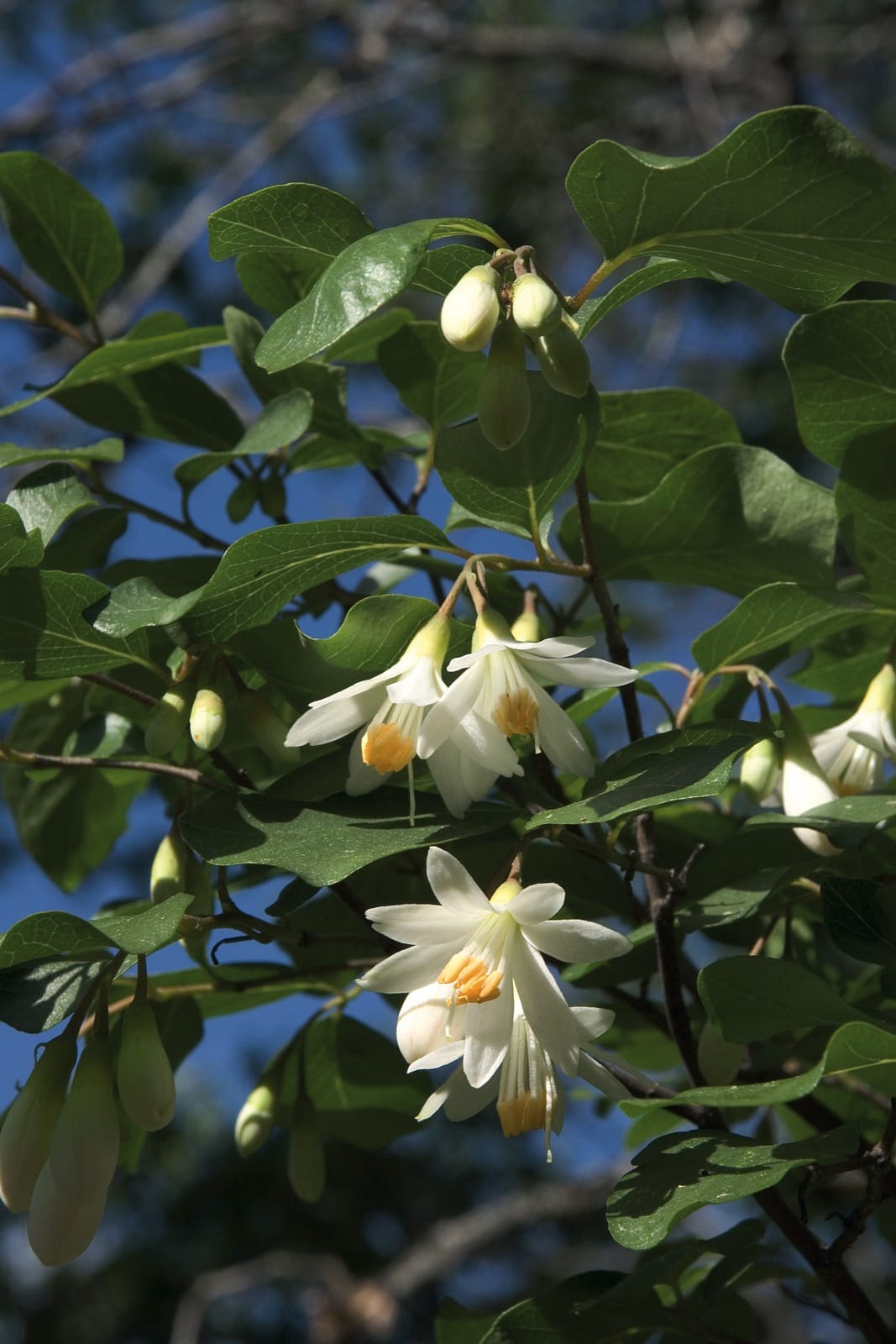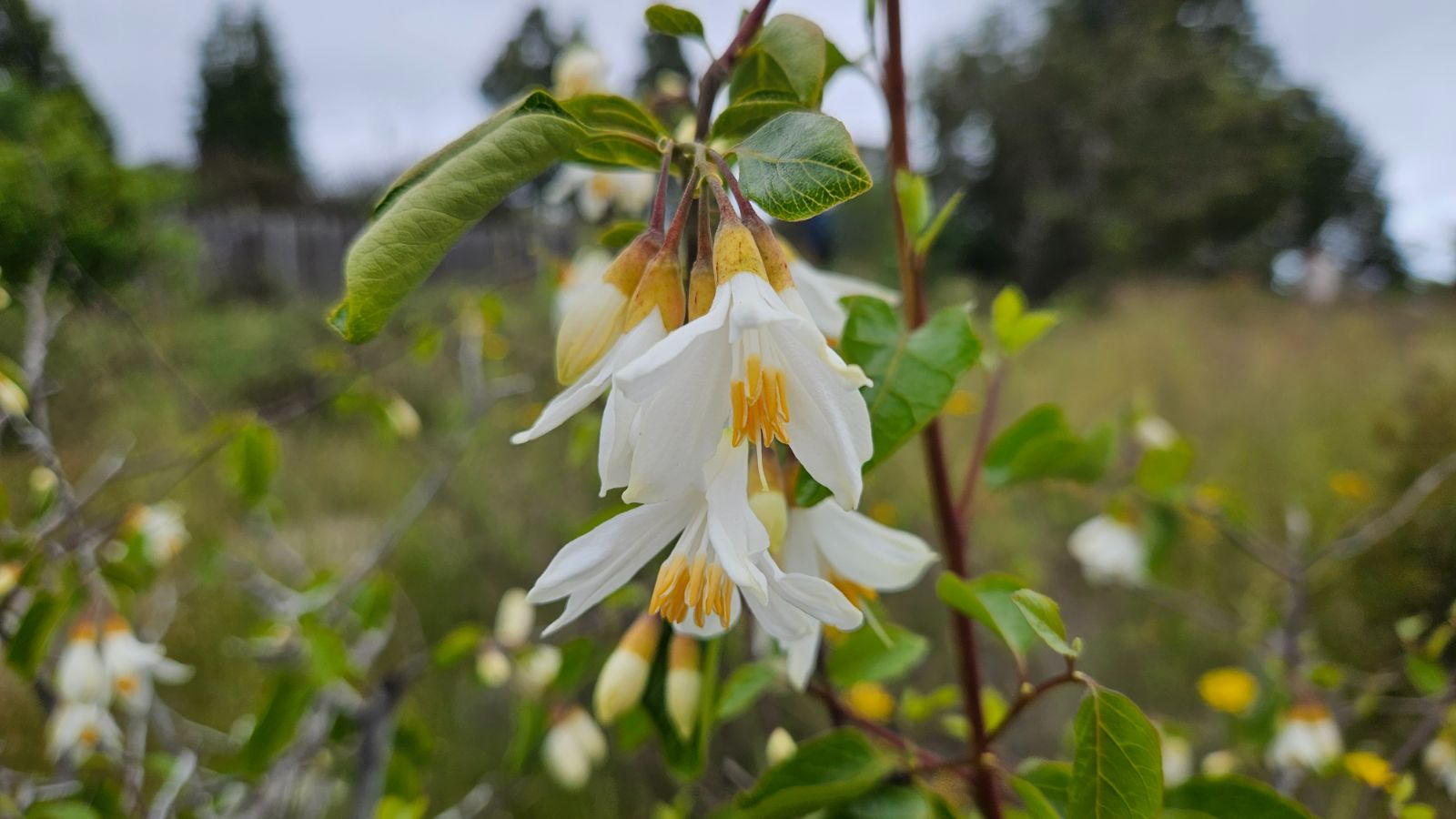Styrax redivivus
Sponsor
Kindly sponsored by
Arabella Lennox-Boyd
Credits
John Grimshaw, Ross Bayton & Alan Elliott (2017)
Recommended citation
Grimshaw, J., Bayton, R. & Elliott, A. (2017), 'Styrax redivivus' from the website Trees and Shrubs Online (treesandshrubsonline.
Genus
Common Names
- California Snowdrop Bush
Synonyms
- Styrax officinalis var. redivivus (Torr.) R. A. Howard
- Styrax officinalis var. californicus (Torr.) Rehder
Other taxa in genus
- Styrax americanus
- Styrax calvescens
- Styrax confusus
- Styrax dasyanthus
- Styrax faberi
- Styrax formosanus
- Styrax grandifolius
- Styrax hemsleyanus
- Styrax hookeri
- Styrax japonicus
- Styrax limprichtii
- Styrax obassia
- Styrax odoratissimus
- Styrax officinalis
- Styrax platanifolius
- Styrax serrulatus
- Styrax shiraianus
- Styrax suberifolius
- Styrax tonkinensis
- Styrax wilsonii
- Styrax wuyuanensis
Shrub to 4 m. Branchlets with white or yellowish brown stellate hairs, bark exfoliating when older. Leaves 3–7.5(–11.5) × 2.5–6.6(–8.5) cm, broadly elliptic to obovate to almost orbicular, upper surface glabrous or with sparse stellate pubescence, lower surface paler, glabrous to densely covered in greyish stellate hairs, with some yellow to brown hairs, especially on the veins, margins entire, apex rounded to bluntly acute, base truncate or rounded to cordate or cuneate; petiole 0.3–1.4 cm long, variably hairy. Inflorescences pseudoterminal, shortly racemose, with one to six flowers. Flowers held on short pedicels that widen from base to apex; calyx with obscure, unequal teeth; corolla with 4–10 (usually 6) lobes, 1.6–2.6 cm long, pure white; filaments to 9 mm, anthers 4–6 mm; ovary densely stellate-pubescent, style pubescent at base or nearly throughout its length. Fruit globose, 1.2–1.4 cm diameter. Flowering March to April (USA). (Gonsoulin 1974, Spongberg 1976, Fritsch 1996, Hickman 1996).
Distribution United States California
Habitat Dry woodland and chaparral in the foothills of the Sierra Nevada, between 150 and 1500 m asl.
USDA Hardiness Zone 8
Conservation status Not evaluated (NE)
The taxonomic status of Styrax redivivus has been much disputed, it having long been considered to belong within S. officinalis, as a variety of that Mediterranean species (see, for example, Bean 1981b). They have now been shown to be distinct species, on both genetic and morphological grounds, with S. redivivus being most closely related to the S. platanifolius group (Fritsch 1996a, 1996b). Fritsch (1996a) provides a key to the three taxa, adapted here.
| 1a. | Stalked stellate hairs on vegetative parts (where present) white or tawny; pedicels 8–17 mm, of equal thickness throughout; corolla lobes widely spreading; pollen pale yellow; Mediterranean Basin | S. officinalis |
| 1b. | Stalked stellate hairs on vegetative parts (where present) golden-yellow to dark brown; pedicels 4–9 mm, widening from base to apex; corolla lobes moderately spreading; pollen orange-yellow; North America | 2 |
| 2a. | Larger undehisced capsules 7–10 mm, hairs on capsule greyish; pedicel 1.3–2.3 times length of calyx; leaves often coarsely lobed or irregularly undulate; Mexico (northeastern), USA (Texas) | S. platanifolius |
| 2b. | Larger undehisced capsules 11–15 mm, hairs on capsule brownish; pedicel 0.5–1.4 times length of calyx; leaves entire; USA (California) | S. redivivus |
The superficial similarities between the Californian Snowdrop Bush and its Mediterranean equivalent S. officinalis are remarkable, but it is good that the various unfeasible explanations of their linkage as varieties of each other can now be laid to rest. Styrax redivivus is a lovely member of the California chaparral and dry woodland flora, combining beautifully with Cercis occidentalis both in the wild and in gardens (S. Hogan pers. comm. 2007), and brings Styrax into the reach of those with hotter drier gardens than tolerated by most others of the genus. It is summer-dormant, flushing out as the winter rains arrive, and is not tolerant of any combination of heat and humidity (S. Hogan pers. comm. 2007). Summer watering should be avoided. It is appreciated by gardeners in California but not widely grown elsewhere.



